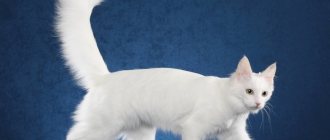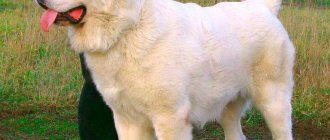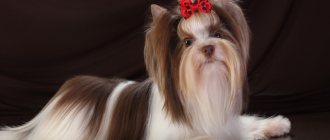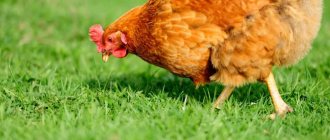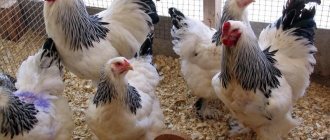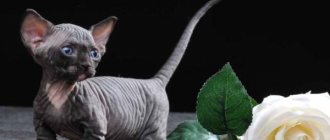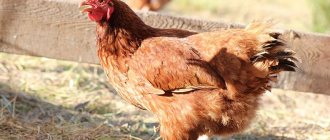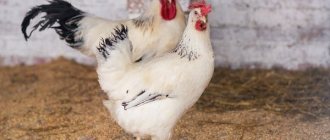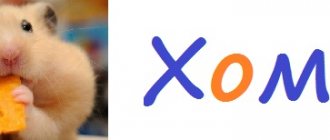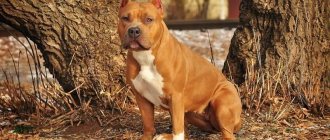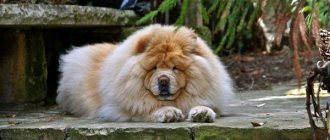The Aberdeen Angus breed of cows confidently ranks first in the ranking of the popularity of cattle. This hornless breed belongs to the meat category and is quite unpretentious in terms of keeping conditions. Breeding this productive and early-ripening breed is a profitable activity that allows you to obtain valuable “marbled” meat.
From the history of the breed
The Aberdeen Angus breed was developed in Scotland in the 19th century. Its name comes from the Scottish counties of the same name. Already at the end of the 19th century, 8.5 thousand Angus animals were delivered to the USA.
Red Angus were bred in the mid-twentieth century. But American breeders refuse to recognize their belonging to the breed.
In North America, black Angus breeding has become widespread, and their meat has become an ideal raw material for the famous American steaks. US farmers promptly organized the Angus Breeders Association, and then created a stud book, which includes only individuals that meet certain requirements.
Originally from France
Charolais
Homeland - France. Today these animals are bred in Europe, and in the USA, and in Africa and in some regions of Russia.
The color is yellow in various shades, fading to white. The head is short with a wide forehead, the neck is massive, fleshy, the chest is wide, but the dewlap is not sufficiently developed. The back is quite wide, slightly sagging. The rear is wide. The Charolais breed of cows is a large, short-legged cattle with loose muscles, thin skin and long, thin hair. The body is elongated. Burenki are hardy and are often used for up to 15 years.
A special feature of Charolais is its very rapid growth. They take first place in terms of growth intensity. The average daily weight gain of calves is 950-1300 g. They are born weighing 38-48 kg. Disadvantages include the fact that cases of difficult calving are sometimes observed. At 4 months, calves already weigh 113-120 kg, at 6 months – 210-260. Cows weigh 785-1045 kg, bulls - 1105-1505 kg!
Slaughter yield of meat is from 60 to 70%.
The main advantages are:
- the growth rate is the highest among other cows,
- excellent yield of meat,
- At the same time, the meat is lean, which is why it is in great demand today.
- ideal for rapid herd development.
Limousine is a French breed of strong and muscular cows
The breed of Limousin cows got its name due to the place where it was bred - the French province of Limousin.
Animals are predominantly red in various tones. Around the eyes and nose there is lighter hair, so these areas look like circles. The body is densely built, but the bones are quite thin, the limbs are strong and muscular. The chest, neck, and sacrum are wide. Horned animals have white horns. The height of adult animals at the withers reaches 140 cm. The weight of queens is 570-654 kg, bulls – up to 1105 kg.
Calves weigh quite impressively at birth: heifers - 35-38 kg, bulls - 35-45 kg. By 8 months of life, weight reaches 240-260 kg and 260-300 kg, respectively. The meat yield at slaughter for bulls is 63-65%, and the meat content in the carcass is up to 83%. Such a high meat content in the carcass is achieved thanks to the thin bones of these animals - almost 6.0-7.0 kg are placed on 1 kilogram of bones. pulp! At the same time, the meat is lean, juicy and has good taste.
Another significant advantage of these cows is relatively easy calving, despite the impressive weight of newborn calves. Limousines are also valued for their endurance, excellent adaptability to poor pastures, unpretentiousness and very high fertility.
Where are they distributed?
Angus are widely reared in:
- Russia;
- USA;
- New Zealand;
- Japan;
- Canada;
- Great Britain;
- Argentina.
Huge black cows are very hardy - Scotland is not the warmest country, so the animals tolerate low temperatures and drought well.
The breed was brought to Russia in 1958. Since then, a gradual increase in their population began. Today they are raised not only for meat, but also used for breeding work to improve the characteristics of local Russian breeds. Places of distribution of the breed in Russia:
- Caucasus
- Stavropol region
- Altai
- Krasnoyarsk region
- Volgograd region
- Voronezh region
- Orenburg region
The breed is actively grown in Kazakhstan and Ukraine.
Features of meat
One of the most famous and delicious meat delicacies is marbled beef. The meat is juicy, light and especially tender. The fat layers do not look like stripes, but like a marble pattern. This is where the name came from. This is exactly the effect of the product that can be obtained by raising Aberdeen Angus bulls using a special technology.
To make the meat even better, they use a method called maturing. In this case, the piece is sent to a special freezer with a certain degree of humidity and temperature. During the procedure, protein molecules break down, and the beef becomes softer and more flavorful. They also use wet (in vacuum packaging) and dry (in a special chamber) maturation technology.
Features of the Aberdeen Angus breed
The main distinguishing feature of Aberdeen Angus cattle is the excellent taste of the meat product. Aberdeen meat has a special structure - thin layers of fat are evenly distributed throughout it. Aberdeen beef is the only meat that does not deteriorate over time. It doesn’t need to be eaten fresh – as it “ripens” it only becomes tastier.
Advantages of the breed:
- They are characterized by high meat productivity. High taste qualities of meat - due to thin layers of fat, meat acquires a unique “marble” structure.
- Large weight and size. They quickly gain weight and increase in size. To avoid obesity, it is important to ensure proper nutrition for livestock.
- Poledness (hornlessness). This is a dominant trait that is actively transmitted by Angus during crossing - in almost 100% of cases.
- Fast weight gain. Calves are born small, their weight is 22-23 kg and 25-26 kg for heifers and bulls, respectively. Heifers are inseminated at 14-15 months. And by the age of two years, bulls have the parameters necessary for slaughter.
- Easily acclimatize to difficult climatic conditions.
- When crossed, the advantages of the breed are well conveyed - meat qualities, precocity and hornlessness.
- Prolific. Retain reproductive abilities throughout life. Almost zero mortality in calves - they have strong immunity and excellent health. Females are excellent mothers.
- They live long. Average life expectancy is 28-30 years.
- Calving is easy. Calves are not large, so problems usually do not arise during calving.
- High productivity.
Marbled Black Angus meat
What exactly is called marbled meat? Marbled beef is the meat of Black Angus or Aberdeen Angus cows and bulls. The muscles of animals contain thin layers of fatty tissue, due to which a marbled pattern is formed on the steaks. The more such layers of fat there are on a piece of meat, the juicier and more tender it will be after cooking.
Such fatty fibers are formed due to the genetic predisposition of animals and proper fattening. For up to 4 months, a young bull is fed fresh grass, and after this time it is switched to grain feed. This diet promotes the formation of thin layers of fat on muscle tissue. In cattle of other breeds, such fatty fibers do not form, and the fat simply grows on top of the muscle. This is why the meat of other breeds is tougher, causing the steak to taste rubbery.
Thanks to such small and thin fatty patches on marbled beef, the steak is soaked in juice and melts in your mouth.
Holstein bullsHereford breed: what is it? Features of breeding cattle Leukemia in cows (bovine leukemia) - a potential health hazard What are the names of cows, what can you call a home nurse
Constitution and exterior
Signs that allow you to unmistakably determine that this is a representative of the Aberdeen Angus breed:
- No horns. Moreover, both in cows and in bulls. The absence of horns complicates life only in the wild, but in home breeding this feature is simply a distinctive feature and dominant of the breed.
- Black suit. There are also Red Angus, whose belonging to the breed is denied by American farmers.
Appearance features:
- Head. Powerful and heavy. But small in size. The animal looks very harmonious - Aberdeen are the real elite of the cow tribe. The forehead is slightly moved forward - as if Angus are angry, the back of the head is narrow. The muzzle is neat and short.
- Torso. They have a wide, deep and heavy body - the cattle look very powerful and strong. The line of the back is almost flat - without deflections.
- Legs. They are forced to carry a large mass, so they are very powerful and muscular - this can be seen with the naked eye. There's a lot of meat on the legs. The legs are short, they stand firmly and evenly on the ground.
- Neck. She is almost invisible - her head seems to immediately go into her shoulders. This feature adds visual power and strength to the exterior.
- Loin and cross. The leg is round in shape, with well-developed muscles.
- Wool. Brilliant. Well protects from the scorching sun and wind.
If Angus are well fed, they have a round shape and look powerful and muscular.
Animal muscles are clearly visible through thin, loose and elastic skin. Angus are distinguished by thin bones - it makes up no more than 15-18% of the total carcass weight. Other parameters are given in Table 1.
Table 1
| Parameter | Breed standard |
| Oblique length of the body, cm | 135-140 |
| Height at withers, cm | 120 |
| Chest width, cm | 46 |
| Chest depth, cm | 67 |
| Live weight of cows/bulls, kg | 450-500/900-1000 |
| Slaughter yield, % | 62-67 |
| Average milk yield per year, l | 1700 |
Aberdeen are large and powerful animals, their appearance can even frighten. However, these black, strong creatures have a very docile character and are not known to show aggression. Only bulls at puberty can be quite ferocious.
Features of keeping Angus dogs
Important
The main goal of breeding the Aberdeen Angus breed is to produce high-quality beef. The peculiarities of keeping animals are directed only in this direction.
Angus are intended for breeding on farms. They need large areas to feed on pasture.
Animals are resistant to low temperatures due to their thick fur and excellent immunity. They are able to survive without shelter. However, it is better to build a barn for them, which does not need to be insulated. It is also not worth putting the animal on a leash.
Cattle easily adapt to heat, but have a negative attitude towards a humid atmosphere and wet soil.
Are there any disadvantages?
According to the description, the breed is magnificent, but does it really have no disadvantages? There are, but they are not so significant compared to the advantages:
- Weak legs.
A contradiction arises - it is simply difficult for a fattened animal to carry its body. Despite the development of the leg muscles, the strength of the legs is not enough to support the obese carcass - the animal begins to fall on its feet. This is why Aberdeen should not be overly fattened. Bulls will be sent to slaughter anyway, so weakness in the legs is not so important, but cows should not be allowed to be overweight! Obesity in cows leads to difficulty transferring weight during gestation and complications during calving. - Arched back. Connoisseurs of cow conformation claim that the carp-like back somewhat spoils the attractiveness of Angus. But this does not affect the quality of the meat in any way! This disadvantage even has its advantages - the structural features allow livestock to easily adapt to external environmental conditions.
- Need large pastures. That is why the breed is more suitable for farmland and hunting grounds.
Productive qualities
The yield of milk and meat from the Aberdeen Angus breed meets high requirements. Cattle is a meat product, and the product has excellent taste and nutritional characteristics. With proper care, cows reach a weight of 700 kg, and Aberdeen bulls - 800, and sometimes 1000 kg. The meat yield from one carcass reaches 60-70%, since the bones of representatives of the breed are quite light, and the fat content is no more than 16-18%. Milk production remains at the level of 1700-2000 liters, but the quality of the milk is relatively low, so Angus are rarely kept for this product.
Productivity
Cattle breeders raise black Scottish cows only for meat - that very valuable marbled beef. What you need to know about Angus productivity:
- The carcass yields 60% pure meat - this is extremely high productivity.
- The female weighs on average 500-600 kg, and if she is fattened purposefully - 700 kg.
- Bulls reach 1000 kg. They are slaughtered at a young age - while the meat is soft and tender. The ideal age for slaughter is 1.5-2 years.
- Over six months, the calf gains weight 152-158 kg - from 22-28 (calf weight) to 180 kg.
Tasters specializing in meat can determine by taste the age at which the animal was slaughtered. It has been noticed that over the years, Aberdeen meat becomes tougher, but in all other respects it only improves.
Angus are the clear leaders in early maturity and meat characteristics among beef cattle. The weight of cows depending on age is presented in Table 2.
table 2
| Periods of life | Floor | Weight, kg |
| at birth | chicks | up to 20 |
| bulls | until 23 | |
| 7-8 months | chicks | 160-180 |
| bulls | 180-200 | |
| 16 months | fattening bulls | 450-460 |
| adult | cows | 500-700 |
| bulls | 750-1000 |
Being on suckling for up to 8 months, calves gain 800-900 g per day. And one cow produces 1600-2000 liters of milk during lactation. Typically, lactating cows are not milked - the milk is used to feed the calf. After 8 months of the dairy kitchen, the calf will weigh about 230 kg.
Purchasing a purebred cow - what to look for
When a person purchases an Aberdeen Angus heifer or bull, he should first read the description of the exterior.
First of all, you need to examine the structure of the body - the belly is rounded, but does not sag, the muzzle is not very fleshy, the skeleton is strong, the hair is smooth, the tail reaches the middle of the leg - these are normal characteristics.
Since the species does not have horns, the teeth will tell about the age and health of the animal. A young individual has about 20 teeth, an older one - 32. They should be strong and symmetrical. Also, do not ignore the eyes, nose, and mouth. It is important that there are no unpleasant discharge or skin changes on them.
Important
But the main thing - the udder - should be smooth and uniform. A clear indicator that the specimen is meaty is its drooping lower part.
And yet, even Scottish cattle produce milk, albeit in smaller quantities than usual. First of all, this is a significant plus for future offspring. Therefore, you should milk her before purchasing. The stream should be thick enough to feed the calf. It doesn't hurt to taste the milk. It should not be bitter or tasteless. Otherwise the female is sick.
Content requirements
For the growth and development of Aberdin, a natural food supply is sufficient - they need extensive pastures, natural or artificial meadows. They tolerate cold and heat well, so as long as snow does not fall and frosts do not hit, they can graze on the paddock.
Angus dogs can be free ranged all year round.
Recommended walking conditions:
- It is desirable that shrubs and trees grow along the perimeter of the pasture - then animals can wander around, chewing grass, without any supervision or care.
- If there are no trees nearby, it is recommended to make a canopy from the sun so that animals can hide under it during the high solstice hours.
- The main task of the herd owner is to provide the cattle with water and mineral supplements; the cows will find everything else themselves. In the absence of a natural reservoir, you need to organize drinking bowls.
- When keeping a barn, it is important to keep everything clean - remove manure and any debris.
Thanks to its natural content, livestock meat acquires a special taste - delicate and refined.
If Angus have water and food, they can stay outside even during the cold season. In winter, cattle can be driven into barns - here they are kept without a leash. Moreover, there is no need to insulate the room - animals warm themselves from the heat generated by their bodies.
Experts talk about the peculiarities of keeping the Aberdeen Angus breed outdoors. The video shows a special feedlot for livestock:
Advantages and disadvantages
The Aberdeen Angus cow breed, like any other, has its advantages and disadvantages.
Representatives of the breed have an excellent ability to quickly adapt to any environmental conditions. Based on this, both northern and southern regions are equally suitable for breeding. Another positive feature that makes Angus cows popular among farmers is their rapid weight gain. The quality characteristics of meat, early maturity and color are genetically determined; only proper care, nutrition and maintenance are needed.
The animal’s digestive tract is formed in such a way that muscles are formed quickly and efficiently. Angus are not afraid of infectious diseases due to their strong immune system. They tolerate temperature changes well, the subcutaneous fat layer is a reliable protection from the cold and a natural heat generation system.
When crossed with representatives of other breeds, the ability for rapid growth and the quality of meat are preserved. The calm temperament and peaceful nature of the animals (with the exception of the behavior of bulls in mating games) make their grazing easy and possible even for a small number of people. And, of course, elite meat, which is highly valued in the world and is suitable for preparing elite dishes.
It would be fair to mention the disadvantages, some of them are significant, according to farmers. First of all, these are disproportionately short legs. The limbs of Angus cows are strong and well developed, but this is not enough for such a large body weight. Therefore, excess weight often leads to limb injuries.
It is very important to monitor your diet and diet. And for pregnant heifers, this situation is completely dangerous: problems can arise not only with the limbs, but also with calving
Animals also need large areas for grazing, which are not so easy to provide. Angus cows grow quickly, but their growth stops at an early age.
Based on everything said above, we can draw the following conclusion: to obtain elite marbled beef, you need to be prepared not only for time and labor costs, but also material ones. Therefore, it is best to breed Angus cows on large farms.
Nutrition
The basis of the diet of Aberdeen cats, which graze on range most of the year, is green food. Since there is no food on the streets in winter, the cattle are given high quality food:
- silage;
- hay;
- roots;
- crushed grain;
- compound feed
It is important to follow nutritional standards so that the livestock does not become fat. Cattle of this breed have a high feed conversion rate. For an animal to gain 1 kg of weight, it needs to consume 6.5 kg of feed units, this can be:
- dry oats – 6.5 kg;
- or meadow grass – 32.5 kg;
- or hay – 13 kg.
Mineral supplements:
- bone flour;
- defluorinated phosphate;
- tricalcium phosphate;
- diammonium phosphate and others.
In order for the meat to have the excellent taste characteristic of this breed, it is not necessary to use concentrates for feeding.
Constantly being on pastures, good-tempered Angus can show distrust of the owner - they simply forget about his existence. It happens that cows try to leave the herd - this must also be taken into account when breeding Aberdeen. Another problem is the maternal instinct of cows. The female may attack a person if she decides that her calf is in danger. And even the absence of horns in Angus will not help a gape person.
Feedback on content
Ivan Krintsiglov, Krasnodar region:
“I have been breeding beef cows for many years. But Aberdeen Angus, in my opinion, is the best. Requires minimal care, eats whatever you give, and can live on grass for a long time. He just drinks a lot. My barn is “cold”; they live there peacefully with the calf. In principle, we don’t even have frosts to insulate it. I bought it from a subsidiary farm. It didn’t cost me much then.”
Andrey Petrov, Republic of Chuvashia:
“We have three cows of this breed. True, two of them are a mixture - and one is pure. But they are not particularly different from each other. They even give the same amount of milk. Everywhere they wrote that they were giving it. But we have enough, even some left over for sale. We had a bull that was recently slaughtered. The meat is tasty and tender. Now we are waiting for more offspring. We hope there will be a calf.”
Igor Skvortsov, Republic of Mordovia:
“We took a bull and a cow from a breeding farm. I liked that their increase was fast. You could say they have grown before our eyes.
There have already been two calvings. Everything went well, without problems. One bull has been castrated and will soon be slaughtered. Everywhere they write that their meat is delicious. I’ve never tried it, it’s even interesting.”
Irina Ponomareva, b. Kazakhstan:
“We have kept animals of this breed for a long time. They are truly unpretentious either in food or care. Quite friendly, calm, loyal. Of course, they didn’t give us much milk, but it was enough for us.
One day we were faced with the fact that one of the cows got sick. The veterinarian said that at one time she should have been vaccinated, but somehow we were not used to it. And now the cattle are sick, there is a risk of infecting other animals, and the price of medicine is simply outrageous. We didn't expect this. Usually we treated cows in case of illness using standard procedures, but here we had to pretty much empty our wallet. This is the disadvantage of Angus. We, of course, cured her. Later we had to vaccinate everyone. So I advise you not to repeat our mistakes and think about the health of animals in advance.”
Fattening
The best meat comes from castrated bulls. Castration is also carried out in calves. Thanks to castration:
- meat fibers become thinner and meat more tender;
- bulls can graze in the same herd with cows; there is no need to organize a separate pasture for them;
During fattening, the basis of the diet is:
- crushed grain;
- hay;
- compound feed - however, they worsen the taste of meat;
- premixes – vitamin and mineral.
Feeding rates for livestock during fattening, giving an average daily weight gain of up to 800 g, are given in Table 3.
Table 3
| Index | Age, months | |||||
| 9-10 | 11-12 | 13-14 | 15-16 | 17-18 | 19-20 | |
| Live weight at the end of the period, kg | 245 | 290 | 335 | 380 | 425 | 470 |
| EKE | 5,9 | 6,3 | 6,6 | 7 | 7,4 | 8,1 |
| Metabolic energy, MJ | 59 | 63 | 66 | 70 | 74 | 81 |
| Dry matter, kg | 6,4 | 6,8 | 7,2 | 7,7 | 8,2 | 9 |
| Crude protein, g | 800 | 820 | 848 | 920 | 965 | 1059 |
| Digestible protein, g | 525 | 560 | 565 | 605 | 632 | 677 |
| Crude fiber, g | 1570 | 1700 | 1870 | 2090 | 2370 | 2491 |
| Starch, g | 768 | 813 | 879 | 980 | 1066 | 1170 |
| Sugar, g | 390 | 398 | 400 | 416 | 430 | 472 |
| Crude fat, g | 180 | 194 | 207 | 230 | 240 | 263 |
| Table salt, g | 31 | 34 | 36 | 40 | 42 | 46 |
The farmer tells how the farm organizes the fattening of bull calves for meat, and what are the features of their feeding:
Description
In terms of physique, Aberdeen have a clearly visible meat direction of productivity. The body has a rectangular shape. The height of the animal is from 1.1 to 1.3 m. With such a small stature, the body length reaches 1.7 m.
Description of Aberdeen
One of the main features of the appearance of Angus is polledness, which is passed on to subsequent generations in almost 100% of cases. As for other exterior features of the breed line, these include:
- large rectangular body with well-developed muscles;
- straight back, sacrum and lower back;
- correctly placed short limbs with developed ham;
- short, voluminous neck;
- deep chest part (depth up to 67 cm);
- small head with short muzzle;
- The skin of such cows is elastic with a thick layer of subcutaneous tissue.
The top of the animal's body is covered with shiny fur. It is designed to protect livestock from sunlight and wind. The coat color is most often black, but brown is also sometimes found.
Angus cows have small udders. It can be completely white or black.
Breeding
Breeding Angus is a profitable business, as their young animals have a high survival rate. Calves are born strong, with good immunity. Feeding on mother's milk, they receive the entire complex of minerals and vitamins.
From 14 months, cows are ready for insemination. They can bear offspring annually. Aberdeen cows often give birth to two calves at once. They are caring mothers:
- feed the calf daily - up to 8 months;
- looks after the offspring;
- protects his calf from any danger.
Cows and calves can be safely released to free grazing - the females will take care of the protection of the young.
A cow's pregnancy lasts 9 months. The birth goes smoothly. Typically, farmers keep 1-2 bulls to improve the herd.
Advantages and disadvantages
Belonging to the Aberdeen breed gives the cattle many advantages, making it economically viable to raise.
- Resilience and endurance. Animals tolerate temperature changes well - a large fat layer and thick hair protect Aberdeen from frost and sun. They can be kept in open areas without harm to health or weight gain.
- High quality meat. The meat of representatives of the breed is tender, juicy, and the fat streaks in the pieces are thin and uniform.
- Easy to breed. Maintaining a herd does not require serious expenses for arranging and heating barns, and high immunity practically eliminates the cost of treatment. Newborn Aberdeen calves also have good health - the survival rate of young animals is 95-99%. Cows take care of their offspring, so calves cause little trouble for the farmer.
- The ability to pass on positive qualities by inheritance. Aberdeens pass on positive qualities to their offspring when crossed with other cows and bulls. They are usually used to improve the health of the herd and improve the economic characteristics of cattle of other varieties.
- Longevity. With proper care, Angus can live at least 28-30 years, maintaining excellent productivity qualities.
Aberdeen Angus cow and calf
The Angus breed has few disadvantages, but farmers need to study them to avoid problems with keeping cattle. These include a wild temperament and aggressive behavior. If animals spend a lot of time free-ranging, they quickly become accustomed to humans and are capable of behaving aggressively.
This is interesting! If representatives of the breed show aggression, they are returned to the barn and kept in a stall for some time.
How is calving going?
The room must be dry and clean. Stock up:
- two towels;
- gauze;
- soap;
- iodine;
- threads;
- bandage;
- 100 g vegetable oil;
- warm water;
- potassium permanganate solution;
- sheets;
- burlap;
- straw rope.
As soon as the cow begins to show anxiety and starts looking around, you need to wash the back of the body and genitals with potassium permanganate. The solution is made slightly pink. Lay dry straw near the cow.
Less than an hour later, the calf is born. It is placed on a clean sheet. The umbilical cord breaks on its own; if it does not break, it must be cut off, leaving 10 cm from the calf’s belly. All that remains is to tie the umbilical cord with threads and treat it with iodine.
Main advantages
Animals of this breed acclimatize well and can easily tolerate low and high temperatures, so they can be kept outside all year round.
Moreover, they continue to gain weight on average 0.6−0.9 kg per day (with intensive fattening - up to 3 kg), the most important thing is to provide sufficient quality food
In terms of nutritional quality and taste, their meat is in no way inferior to Herefords and is ideal for steaks - “marbled” beef with thin layers of fat is very juicy and tender. This meat structure appears due to the fact that in Aberdeen Angus cattle the bulk of the fat is deposited in the thickness of the muscles, and not under the skin.
The most valued meat is that certified by the US Department of Agriculture with the label “Certified Angus Beef.” This marking may be on meat of other breeds of animals if they meet the requirements for the age of the animal, appearance and carcass quality.
Excellent meat properties and polledness are transferred to calves even during crossing with cattle of other breeds. As a rule, Angus are crossed with dairy cows to improve the health of the herd or increase the meat performance of the latter. Aberdeen Angus are the best beef breed in the world in terms of growth rate, meat quality and carcass presentation.
In addition, this is the fastest breed: cows are inseminated after 13-14 months (and not after 19, like many breeds) with a minimum weight of 330-360 kg. Bull calves at 18 months weigh 470−520 kg.
An economically profitable breed: no expensive treatment, large amounts of feed and heated barns are required. Angus have good health and can remain free-grazing all year round if food is available.
Easy calving, as calves are small at birth. Calves are born weighing 15−22 kg, while most other breeds weigh 25−35 kg. Due to the low weight at birth, calving occurs easily, without any difficulties, even for first-time heifers. From the first day, calves begin to graze with their mother and remain suckled until they are 8 months old.
Almost zero mortality of newborn calves. Calves have good health and good immunity, which they receive from their mother during the suckling period. Cows are characterized by good maternal instincts.
Diseases
From a genetic standpoint, black and red Angus breeds are identical. But it is believed that red cows are less cold-resistant. However, there is no scientific evidence for this. Aberdeen are carriers of 4 recessive genetic diseases. They appear when both parents have the gene. According to statistics, even under such conditions, only one out of 4 calves gets sick.
To identify carriers of bad genes, a DNA test is performed on individuals.
Genetic diseases:
- Contracture arachnodactyly. There is a deterioration in the mobility of the hip joints.
- Arthrogryposis multiplex . Crooked joint disease. Breeders call calves with this condition “twisted.” The joints have poor mobility, and the leg muscles are atrophied.
- Neuropathic hydrocephalus . It is also called dropsy of the brain. Calves have large, shapeless heads.
- Dwarf traits.
- Notomelia. Extra limbs.
- Osteoporosis. Brittle bones.
Calves with such genetic diseases are culled - they are not suitable for breeding. A cow's pregnancy lasts 9 months. The birth goes smoothly. Typically, farmers keep 1-2 bulls to improve the herd. Purebred Aberdeen Agnus cows should be purchased from breeding farms. Here you can get material for insemination.
Breeding farms in Russia that have breeding stock:
- "Paris Commune" - in the Volgograd region;
- "Avryuz" - Bashkortostan;
- LLC "Sputnik" - in the Leningrad region. Vsevolzhsky district, village. Lepsari;
- State Unitary Enterprise ESH "Dyatkovo" - in the Bryansk region. and many others.
Where to buy purebred heifers, which nurseries raise them
In Russia, you can purchase an Aberdeen Angus heifer or bull at breeding farms. They are located in the Volgograd, Sverdlovsk regions, Krasnodar Territory, Kabardino-Balkaria, and Bashkortostan. Breeders are engaged in breeding pure color, based on precocity and meatiness.
In addition, purebred cows can be purchased from farms and private owners:
- LLC "Podsobnoe Khozyaystvo", Republic of Mordovia. American selection heifers up to 350 kg - 90 thousand rubles, over 350 kg - 260 thousand rubles. Black bulls of American selection weighing from 400 kg - 130 thousand rubles, red varieties of American selection weighing from 400 kg - 150 thousand rubles, heifers weighing from 450 kg - 160 thousand rubles.
- Stevenson-Sputnik LLC, Voronezh region. Bulls, heifers, heifers of the Aberdeen Angus breed.
- , Naberezhnye Chelny offers heifers and heifers. Delivery available, documents included.
- Farm of A. Moskvin, Kirishsky district, Leningrad region. Aberdeen Angus cattle.
- IP Shaimardanov, Naberezhnye Chelny. Heifers and heifers.
- LLC "AgroLax", Voronezh. Aberdeen Angus bulls.
- "TrendAgro", Magnitogorsk, Chelyabinsk region. Breeding cattle weighing 350-500 kg. Price is negotiable, from 300 rub./kg. They sign an agreement and provide a package of documents.
- Pallasovka, Volgograd region. Aberdeen cattle and crossbreds. The cattle is young and has undergone veterinary treatment. The price for the entire herd is 3 million rubles.
- JSC PZ "Sputnik", St. Petersburg. The breeding plant is engaged in breeding, raising and selling livestock.
- LLC "MYASPROMTORG", Penza. Purebred heifers. Cost 85 thousand rubles/piece. There are documents, work is being done with grants, delivery is being organized.
- LLC "Pavskoe", Pskov. Breeding cattle of Aberdeen Angus color.
- Alexandrov, Vladimir region. Heifers, breeding heifers. Price from 110 thousand rubles. Per head. Bulls weighing from 500 kg. Price 120 thousand rubles. by the head (per tribe).
Calf care
The keeping of calves is divided into milk and post-milk periods. The most important stage in the life of a calf of any breed is the first two weeks. Angus breed very strong offspring. The mortality rate is practically zero. Conditions for keeping calves during the first 14 days:
- Calf nurseries should be located in a room with good ventilation and lighting.
- The barn where the calves are kept must have a constant temperature.
- There should be no drafts. Calves have poorly developed body thermoregulation, and changes in temperature will negatively affect their health. Angus, having a strong immune system, unlike calves of other breeds, practically do not get sick.
- The nursery must be kept clean to prevent infectious diseases.
Calves get all their nutrients and immune substances from colostrum, which is the nutritional fluid the cow gives after calving. Immediately after birth, the calf must suckle the udder.
Please note the following points:
- For the first time, the calf should drink 1-2 liters of colostrum.
- The frequency of feedings should be 4-5 times a day.
- If the calf is weakened, it should eat more often - 5-6 times 1 liter, then 2 liters.
- The daily norm of colostrum is 8-10 liters.
- On the 5th day, the calf is given boiled water. Its temperature should be the same as that of fresh milk – 37 °C.
- From the 7th day - to develop digestion, calves are given small-stemmed, high-quality hay.
Calves are weaned from their mother at the age of 6-8 months. Calves enter the post-milk period of development. Calves need to get enough sun to produce vitamin D, which is needed for bone growth. Gradually, the calves switch to an adult diet, walking on pastures with cows, they have access to nutritious green food.
Recommendations for maintenance and feeding
The goal of raising Angus is to quickly obtain high-quality meat, so the conditions of detention are aimed at this. It is not recommended to use various concentrated feeds. Green food on an extensive pasture will contribute to rapid weight gain and impart a special delicate taste to meat products. Free range is good for Angus dogs all year round. Additional food will only be needed during the period when the ground is covered with snow.
The ideal option would be if there are bushes, forest plantations and ponds along the perimeter of the walking area. In this case, the unpretentious herd will not need additional care.
To obtain the famous marbled beef, farmers mainly breed bulls, which are sent for slaughter at the age of 1.5 to 2 years. This meat is intended for preparing high quality steaks. The meat of bulls castrated at an early age is considered to have the most exquisite taste. Such animals are called oxen and can be found on the same pasture with cows.
Comparison with “competitors”
Angus differ from other breeds:
- Good health and low mortality among calves.
- They rarely get sick, and even genetic diseases affect only 25% of calves if both parents have the disease gene.
- They can graze on range all year round.
- Lactating calves – up to 8 months, instead of 3.
- Calves are born small - only 16-23 kg, while in other breeds - 20-30 kg. Therefore, childbirth is easy and without complications, even in first-calf heifers.
- Calves can graze with their mother from the first day of life.
- They are characterized by high early maturity.
Main competitors:
- Herefords. This is the most common breed. They, like Angus, can easily withstand harsh conditions and can graze year-round. They are distinguished from Angus by their more powerful front part. In many ways, the breeds are similar; Herefords are also distinguished by easy calving, fertility, low calf mortality, longevity, and high feed conversion. And most importantly, they also produce excellent “marbled” meat.
- Simmentals. Another popular meat breed. They are also large and muscular, like the Aberdeen. In addition, Simmentals are characterized by high milk production. The meat is devoid of excessive fat deposits, but in terms of taste it is inferior to Hereford Angus meat.
- Limousines. Like Aberdeen, they are distinguished by easy calving and good weight gain; their meat contains little fat. But they are extremely demanding in terms of food and living conditions; they are considered conditionally suitable for year-round grazing.
Table No. 4 shows a comparison of the economically useful qualities of Angus, Simmental, Hereford and limousine:
Table 4
| Indicators | Bulls | Cows | ||
| Herefords | ||||
| Height at withers, cm | 140-150 | 135-140 | ||
| Weight, kg | 1000-1200 | 600-750 | ||
| Daily weight gain of calves, g | 900-1300 | 850-1100 | ||
| Angus | ||||
| Height at withers, cm | 130-150 | 120-140 | ||
| Weight, kg | 900-1200 | 500-700 | ||
| Daily weight gain of calves, g | 1000-1200 | 850-1100 | ||
| Simmentals | ||||
| Height at withers, cm | 150-160 | 140-145 | ||
| Weight, kg | 1200-1400 | 750-800 | ||
| Daily weight gain of calves, g | 1200-1400 | 900-1200 | ||
| limousines | ||||
| Height at withers, cm | 145-155 | 135-140 | ||
| Weight, kg | 1000-1200 | 650-700 | ||
| Daily weight gain of calves, g | 1100-1300 | 900-1100 | ||
The Aberdeen Angus breed is a real treasure of livestock breeding. This breed is one of the few that does not require special care - the animals are ready to live in their natural environment all year round. They do not require supervision; care for the herd is minimal. By breeding Angus, you get a precious product - unique, juicy meat that is highly valued.
0
0
Copy link
How and what to feed cattle
When feeding the Aberdeen Angus breed in summer and spring, experts do not recommend using different concentrated feeds, because only greens contribute to weight gain and the special taste of the meat. Preferred are forests and bushes in the pasture area, as well as a drinking pond.
In winter, when there is no greenery, you can introduce feed and household waste into the animal’s diet. Livestock can use roughage in large volumes, as well as fodder beets and compound feed. Straw should be given in crushed form. It is advisable to mix it with the main food.
General characteristics of Black Angus
The Aberdeen Angus breed (or Angus, as farmers call it) was bred in the 19th century by the Scots from the counties of Angus and Aberdeen. These red or black hornless beef cattle are distinguished by their high resistance to adverse weather conditions and low temperatures, so often observed in their homeland of Scotland. It adapts well to sparse vegetation during the grazing period and arid climate, which is why the Aberdeen type of cattle is often bred in steppe arid areas.
At the beginning of the 20th century, 9 thousand heads of Aberdeen Angus were brought by ship to America for breeding stock.
A few years later, the Angus Breeders Association was organized in America, and a couple of years later the world’s first stud book appeared. Since 1888, only those animals whose ancestors are already listed in it can enter it.
At the end of the 20th century, red Angus were bred, but in America their belonging to the breed is not recognized and is not recorded in the stud books.
In which countries are Aberdeen Angus cattle kept?
This meat-oriented breed is widespread in Russia (since 2008), New Zealand and Australia, the United States, Japan, Argentina, Canada, and England.
In our country, Angus are kept in the steppes of Stavropol, in the Caucasus, in the Krasnoyarsk Territory and Altai, on farms in the Orenburg, Voronezh and Volgograd regions.
The breed is often used in the beef cattle industry of Kazakhstan, where very low and high temperatures prevail, as well as arid steppes, and Ukraine, usually in the west of the country and in the Kyiv region.
Exterior of the famous breed
Distinctive features of Black Angus bulls are polled and black in color. Their Aberdeen dogs are passed on to their descendants even when crossed with individuals of other breeds. These small cows rarely reach 120 cm at the withers.
The head of adult Angus is small, with a narrow nape, the neck is thick and of short length, the chest is wide, the withers and back are level, the limbs are short, the muscles of the ham extend to the hock joint, the skin is thin and loose (due to subcutaneous fat) , covered with soft black wool.
The photo shows Aberdeen Angus already in adulthood: the physique of young animals is less proportional (calves have rather large heads and more elongated legs).
